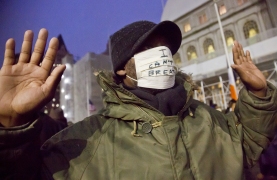By
Media Diversified on
March 2, 2015 • (
9 Comments )
The Logic of Whiteness
by
Ronald A. Kuykendall
The recent fatalities involving black men and white police have a long history, coupled with a pattern of government inaction and unwillingness to take action against white perpetrators and police abuse in cases of violence against African Americans. For example, the failure of conviction or prosecutorial indictment in the fatal incidents involving Trayvon Martin in Miami, Florida; Michael Brown in Ferguson, Missouri; 12-year-old Tamir Rice in Cleveland, Ohio; and Eric Garner in New York City. The government’s response, if there is a response, is usually the creation of a committee, commission, or task force to investigate and make recommendations or devise new guidelines that are typically not followed. In some cases funding is allocated for special training.
The decisions reached by the authorities surrounding these egregious racial incidents seem to defy logic. They underscore, once again, how little has changed in the relationship of African Americans to the legal system and to the police. These incidents usually generate rallies, marches, and protests and calls for a national dialogue or conversation on racial injustices. For a limited time there is a response from civic organizations, churches, colleges, and universities that sponsor community forums and panels. The fact that we keep having these racist incidents and then hearing about the necessity for dialogue is evidence of some of the complexities of structural racism, but also the limitations of reactive conversations.

The notion of a national dialogue, or any dialogue, for that matter, presumes that talking about an injustice will somehow clear up the misunderstandings, misperceptions, assumptions, ignorance, alienation, violence, and microaggressions affiliated with racism; that such a dialogue would be a transformative moment. But the idea that within the United States we could actually have a national dialogue on racism is not only illusory. It is a misunderstanding of how whiteness as a racialised identity and its consequences — racialisation and racism — reinforces, perpetuates, and maintains white privilege and the effects of that privilege: white hegemony and white supremacy.
The performance of whiteness, as an institutionalized structure and practice, limits the terms of social interaction and is predicated on the power to grant recognition and legitimacy. In other words, the performance of whiteness exercises the right to impose meaning, and world-view on the racialised other; and so, the performance of whiteness makes the issue of race and racism undiscussable. The very nature and logic of whiteness is
antidialogical.
In using the term
antidialogical, I am referencing the meaning of that word as used by Paulo Freire, in his
Pedagogy of the Oppressed. In
Pedagogy, Freire asserts that antidialogue is a relationship between self and other, which becomes, in the sense used by Jewish philosopher Martin Buber, an “I-It” relation. That is, self sees the other as an object to be dominated, and so the relationship becomes oppressive. To be antidialogical is to exist in a vertical relationship of dominance and subordination. Antidialogical activity impedes communication and reduces the other to the status of a thing. Antidialogue is a means of dominance which dispossesses the other of their testimony and their expressiveness. It is an indispensable tool in the preservation of dominance and oppression, and consequently the preservation of whiteness.
When you think about how the logic of whiteness is performed, that is, the reasoning upon which whiteness is predicated, what stands out is the justification on which whiteness rests:
innocence. Whiteness, as a structurally infused practice expressed through racism, self-exonerates, and justifies hostility toward those categorized as inferior. As such, racism, as described by the Tunisian writer on race and colonization, Albert Memmi, is “a defense mechanism and an alibi” (160). It both protects the white perpetrator of racial aggression and hostility and rationalises the imposition of that aggression and hostility.
Consequently, as part of the logic of whiteness, there is the tendency to blame the victims for the crimes of their white oppressors. Hence, the white view of issues and tensions associated with racism focus on African American attitudes and conduct that need to change. Accordingly, whatever difficulties African Americans face are a consequence of their own attitudes and behavior, a failure to adapt to the demands and norms of the dominant white culture.
This blaming the victim argument, popularized in academia during the 1960s, locates racial inequality and African American social pathologies within abnormal or deviant African American cultural traits. These traits are seen as responsible for the development of attitudes and values that limit opportunities or prevent escape from poverty. Through racialisation, this “tangle of pathology” — drug addiction, crime, low educational achievement, and economic problems, reinforced by a weak family structure – is seen to perpetuate abnormal and deviant cultural traits. Thus, the biological referents of nineteenth century racism based on notions of genetic and biological difference have shifted. African American cultural adaptations, rather than racialised inequalities, are now more likely to be seen as responsible for social pathologies and injustices.
The Logic of Whiteness



 Maybe police your own fkn neighborhoods and stay outta ours. Terrorists pigs.
Maybe police your own fkn neighborhoods and stay outta ours. Terrorists pigs.

 did i say it was?
did i say it was?
 i was telling them how it is in Jacksonville and they were
i was telling them how it is in Jacksonville and they were 
 acting like it was some paradise.
acting like it was some paradise.
